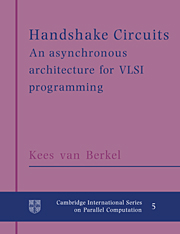Book contents
- Frontmatter
- Contents
- Foreword
- Preface
- 0 Introduction
- 1 Introduction to Tangram and handshake circuits
- 2 Examples of VLSI programs
- 3 Handshake processes
- 4 Handshake circuits
- 5 Sequential handshake processes
- 6 Tangram
- 7 Tangram → handshake circuits
- 8 Handshake circuits → VLSI circuits
- 9 In practice
- A Delay insensitivity
- B Failure semantics
- Bibliography
- Glossary of symbols
- Index
2 - Examples of VLSI programs
Published online by Cambridge University Press: 14 January 2010
- Frontmatter
- Contents
- Foreword
- Preface
- 0 Introduction
- 1 Introduction to Tangram and handshake circuits
- 2 Examples of VLSI programs
- 3 Handshake processes
- 4 Handshake circuits
- 5 Sequential handshake processes
- 6 Tangram
- 7 Tangram → handshake circuits
- 8 Handshake circuits → VLSI circuits
- 9 In practice
- A Delay insensitivity
- B Failure semantics
- Bibliography
- Glossary of symbols
- Index
Summary
This chapter introduces further Tangram constructs out of which more interesting programs can be described. These constructs include expressions, guarded selection, guarded repetition, and choice. The choice construct supports mixed input and output guards. Guarded selection and choice also introduce nondeterminism.
These constructs are introduced by means of concise and telling examples, namely a simple FIR filter, a median filter, a block sorter, a greatest common divisor, modulo-N counters, various stacks (including a specialization as a priority queue), and a nacking arbiter. In many cases handshake circuits are presented and explained with reference to the Tangram program text. Where relevant, circuit size, speed, and power consumption are analyzed.
FIR filter
A Finite Impulse Response (FIR) filter is a component with a single input port and a single output port. Input and output communications strictly alternate, starting with an input. For a FIR filter of order N the output values are specified as follows. The value of the ith output, i ≥ N, is a weighted sum of the N + 1 most recent input values. The N + 1 weight factors are generally referred to as the filter coefficients. The first N output values are left unspecified.
A very simple FIR filter is used to introduce Tangram expressions and their translation into handshake circuits.
- Type
- Chapter
- Information
- Handshake CircuitsAn Asynchronous Architecture for VLSI Programming, pp. 27 - 44Publisher: Cambridge University PressPrint publication year: 1994
- 1
- Cited by



